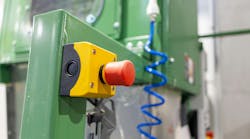A Control Design reader writes: What are the acceptable forms of an e-stop button? We typically see the mushroom-head push button, but are other manual actuators acceptable under the appropriate standards? What about color—red and yellow? Are remote or touchscreen e-stops feasible and compliant?
Answers
Recommended types
Emergency-stop devices or buttons are safety control devices designed to enable workers to swiftly stop machinery or equipment operation during critical situations or an emergency, designed to prevent accidents, injuries or damage to machinery by providing a fast and easily accessible means of shutting down equipment.
E-stops serve as fail-safe control switches. They are used when the machinery's master switch cannot be accessed in time. The emergency-stop pushbuttons are engineered for rapid response and are wired along the control circuit of the machinery.
E-stop buttons are designed for easy handling and can be operated by hand or by a footswitch on the ground level. The recommended types of e-stop buttons are:
- Mushroom-head pushbutton: This is the most common and widely accepted form. It features a large, mushroom-shaped button that is easy to identify and press during emergencies. Its distinctive shape and size make it a widely recognized standard for emergency-stop controls.
- Palm button: Palm buttons are also acceptable forms of e-stop buttons. These buttons require the operator to press them with their palm, ensuring deliberate and immediate action.
- Push-pull: The push-pull emergency button is pushed to lock into position to cut off the power to the machinery and pulled back to reset to its original position.
- Twist to release: This can be pushed to cut off electrical power to the connected industrial machinery. However, it requires twisting the button to reset after activation. This helps prevent accidental reactivation.
- Key release: These buttons are pushed in and locked to cut off the electrical contact. It can be unlocked using a removable key provided with the e-stop.
- Pull cord: Pull-cord e-stop switches are used where the operator may need to stop the machinery from a distance or where hands-free operation is necessary. The emergency-stop command is triggered by pulling on the tensioned pull-wire. Additionally, all these switches incorporate cord-breakage monitoring. If the cord is pulled or breaks, the normally closed (NC) contacts are forcefully opened while the normally open (NO) contacts close. Restoring the pull-cord emergency stop switch requires deliberate resetting action.
- Foot-operated switch: These e-stop switches work as permissive switches in machines and plants where operators need to maintain balance or control over the equipment. Operators can press down on the foot pedal to stop the machinery, allowing them to maintain control while keeping their hands free for other tasks.
- Wireless e-stop systems: Wireless and remote emergency stop switches provide convenience in operation without physical tethering to the switch. These switches typically feature wireless communication capabilities for remote activation. In emergencies, they can swiftly halt machinery or processes from a distance, enhancing safety and responsiveness in industrial settings.
Regardless of the form, all e-stop buttons should be easily identifiable, readily accessible and marked with universally recognized symbols. They should also prevent accidental activation while enabling quick and decisive action in emergencies. Additionally, they must comply with relevant standards such as American National Standards Institute (ANSI), International Organization for Standardization (ISO) and Occupational Safety and Health Administration (OSHA) regulations.
Emergency-stop categories refer to different levels of safety and functionality associated with e-stop systems in industrial settings. The e-stop categories are broken down into three general groups to ensure proper design and implementation of safety measures and are defined by ISO 13850 and International Electrical Commission (IEC) 60204-1 standards:
- Category 0: This category involves immediately removing power to the machinery or equipment without safety monitoring functions. It's the most basic emergency stop, used only when immediate shutdown is necessary. In this case, the machine may continue to run mechanically, posing a potential danger or risk of damage and injury even after actuation.
- Category 1: In this category, the emergency-stop function is initiated by a single action. The machine is stopped in a controlled way, followed by cutting off the energy supply to the drive elements. For example, heavy loads under high acceleration or deceleration rates require a controlled stop to prevent hazards.
- Category 2: It is a powered stop category that does not remove power from the machine. This category must not be used to switch off in dangerous situations, but it is still a helpful feature.
A risk assessment of the machine must be carried out to determine the correct stop category for an emergency stop. It is also used to determine whether an emergency stop is necessary.
The mushroom-head pushbutton is the most commonly observed form of e-stop button. However, other manual actuators are acceptable under the appropriate compliance and standards, such as ANSI B11.19-2010, ISO 13850:2015 and OSHA 29 CFR 1910.212. These include palm buttons, pull cords, foot pedals and paddle buttons, among others listed.
According to ANSI Z535.1-2017 and OSHA 1910.144, an emergency-stop button must be colored red to ensure quick identification in emergency situations. Red signifies danger and is universally recognized as indicating the need for immediate action.
The area surrounding the red mushroom button, background or housing, should be yellow, as per ANSI Z535.4-2011 and OSHA 1910.144 for improved visibility. National Fire Protection Association (NFPA) 79 reinforces such yellow enclosures, incorporating a prominent yellow emergency-stop label or adding yellow coloring to the stem of the button. The standard specifies that the red/yellow color combination should be reserved exclusively for emergency-stop applications.
Wireless e-stops and remote e-stops are feasible and comply with ISO 13849, ISO 13850:2015, ANSI B65.1-2005, IEC 60204-1:2005, and IEC 62745 standards.
In a scenario where an operator performing maintenance cannot reach the machine's hardwired emergency stop, the wireless e-stop can be invaluable. The wireless e-stop system allows safer access closer to operational activities. In addition to the safety function, it has a handheld transmitter featuring a button and switch that can be freely configured for user-specific control tasks for convenient operation. Secure operation is ensured regardless of the user's location, and the system allows facilities to be switched off in dangerous situations. It promotes universal usability for maximum mobility and safety.
A touchscreen e-stop is not allowed. Graphical representations of emergency-stop buttons—icons—on a human-machine interface (HMI) or flat panel display are not permissible for e-stops operation.
Ankur Tomar, solutions marketing manager / Newark
Red/yellow exclusively
Emergency-stop buttons are critical devices to ensure safety. Numerous established standards guarantee their effectiveness and visibility. According to IEC 60204, it is imperative for e-stops to be readily identifiable and easily accessible, should an operator detect a machine hazard.
The most common type of e-stop buttons, as specified by ISO 13850, IEC 60204, IEC 60947, and NFPA 79, feature an easy-to-operate mushroom-head, with a red button against a yellow background for enhanced visibility.
NFPA 79 does include other types of actuations such as pull cords and foot-operated controls. It does specify “emergency stop devices shall be colored red. The background immediately around push buttons and disconnect switch actuators used as emergency stop devices shall be colored yellow. The red/yellow color combination shall be reserved exclusively for emergency stop applications.”
Along with the form and color requirements, there are additional regulations for e-stops. These include:
- directly opening an electrical contact
- self-latching in the open state
- requiring manual reset to resume operation.
While a touchscreen e-stop cannot meet these requirements and thus would not be compliant, a remote e-stop that fulfills all the discussed criteria would not only comply but also offer potential advantages. This is particularly relevant in scenarios where mobility around the machinery is necessary, and the observer may not have an e-stop easily accessible.
Mike Davis, product manager industrial electronics / Misumi USA
NFPA 79
In the United States, we can refer to NFPA 79 for what an e-stop device must do and look like. As stated in Chapter 10.7.1, e-stop devices do not have to be buttons; they can also be pull cords, foot-operated switches and push bars, just to name a few examples. NFPA 79—10.7.3 says that the actuators, the part that is interacted with, of e-stop devices, shall be red with an immediate background yellow. In the same section, the shape of e-stop buttons specifically shall be palm or mushroom-head type. Lastly, section 10.7.2 says that e-stop devices shall not be flat switches or graphical representations, meaning that software e-stop, such as from an HMI screen, are not allowed.
As for remote e-stop devices, these are certainly allowed, provided that they adhere to the requirements outlined in NFPA 79. I won’t go through all of the requirements, but I will list a few important ones:
- The e-stop function shall override all other functions regardless of operation mode.
- Power to the machine actuators—motors, presses—shall be removed as quickly as possible without introducing other hazards.
- Reset of the e-stop device shall not cause the machine/process to reset.
- More details on emergency stop functions can be found in NFPA 79, chapters 9 and 10.
Noah Greene, product specialist—safety / Phoenix Contact USA





